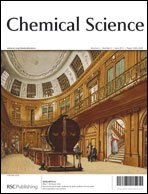First demonstration of two-step FRET in a synthetic supramolecular assembly†
Abstract
We report a trichromophoric pseudorotaxane (3NPC) that demonstrates a two-step FRET-based relay comprising of primary donor–primary acceptor/secondary donor–secondary acceptor pairs. To achieve this, naphthalene (1) and coumarin (3) were used as the primary donor and secondary acceptor, respectively; while pyrene (2 or T) unit, having spectral overlap with both 1 and 3, was used as the primary acceptor as well as the secondary donor. Results of time resolved and steady-state emission studies reveal that sequential resonance energy transfer (FRET 1 → 2 → 3) and direct resonance energy transfer (FRET 1 → 3) processes are operational simultaneously. In the sequential energy transfer process (1 → 2 → 3) of the triad system, pyrene acts as a transmitter and makes the whole supramolecular assembly behave as a linear energy transferring wire. Sensitised emission of the coumarin moiety, i.e. the secondary and eventual final acceptor, offers the possibility of evaluating the performance of this linear trichromophoric system by one and two-step FRET mechanisms. Formation of an interwoven complex between the host (NCC24O8) and the guest (T) components, utilizing various non-bonding interactions (intercomponent [N+–H⋯O], [C–H⋯O] and π–π stacking interactions) has been confirmed by 1H NMR studies in solution and a single crystal X-structural study in the solid state. The formation constant (Kf = 2.31 × 103 M−1) for the [2]pseudorotaxane was evaluated using isothermal titration calorimetric studies. The complex gives rise to the first crystal structure of a self-assembled [2]pseudorotaxane that demonstrates sequential two-step FRET based energy transfer in a self-assembled triad that is held in an assembly through non-covalent interactions, such as hydrogen bonding and π–π stacking.


 Please wait while we load your content...
Please wait while we load your content...